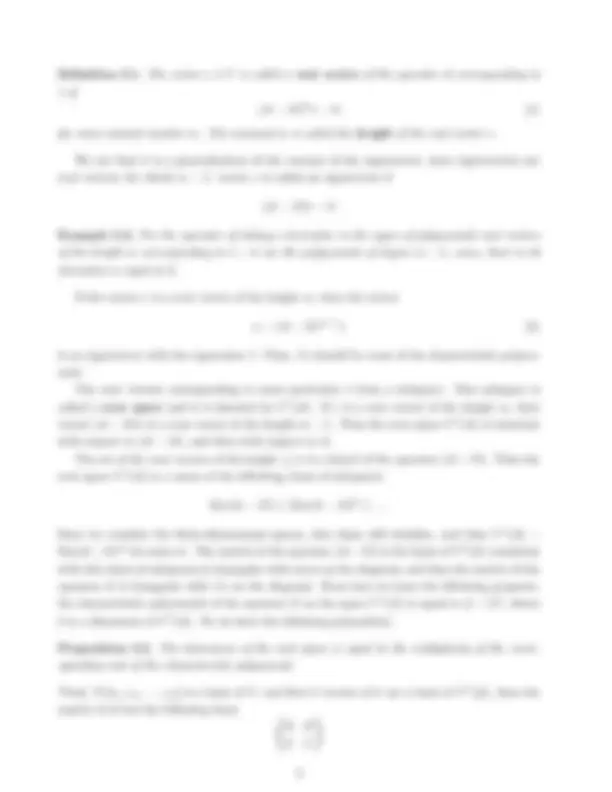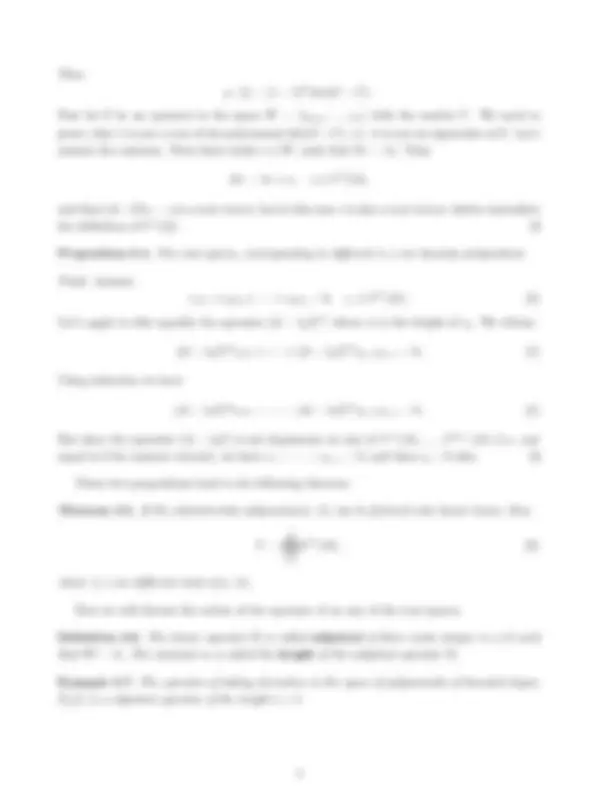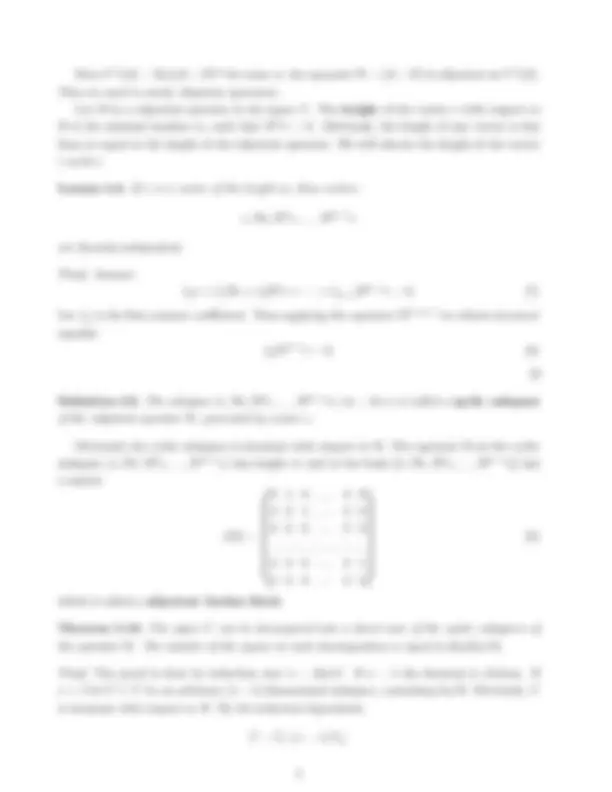





Study with the several resources on Docsity

Earn points by helping other students or get them with a premium plan


Prepare for your exams
Study with the several resources on Docsity

Earn points to download
Earn points by helping other students or get them with a premium plan
Community
Ask the community for help and clear up your study doubts
Discover the best universities in your country according to Docsity users
Free resources
Download our free guides on studying techniques, anxiety management strategies, and thesis advice from Docsity tutors
Direct Sum of Vector Spaces, Sum, Linearly, Independent, Direct Sum, Vector Space, Skew, Symmetric, Invariant Spaces, Subspaces, Invariant, Jordan, Canonical, Form, Decomposition, Root Vector, Height, Root Space, Dimension, Nilpotent, Jordan Block, Jordan Matrix, Eigenvalue, Linear Algebra, Lecture Notes, Andrei Antonenko, Department of Applied Math and Statistics, Stony Brook University, New York, United States of America.
Typology: Study notes
1 / 7

This page cannot be seen from the preview
Don't miss anything!




In the first part of this lecture we will consider some more concepts from the theory of vector spaces.
Definition 1.1. Sum of two vector spaces U and V U + V is a vector space which consists of all vectors u + v, where u ∈ U and v ∈ V.
Definition 1.2. Vector spaces U 1 , U 2 ,... , Un are called linearly independent if from u 1 + · · · + un = 0, where ui ∈ Ui it follows that ui = 0 for all i.
Sum of the linearly independent vector spaces is called a direct sum of these vector spaces and is denoted by U 1 ⊕ · · · ⊕ Un.
Definition 1.3. The vector space V is said to be equal to a direct sum of vector spaces U 1 ,... , Un V = U 1 ⊕ · · · ⊕ Un
if any vector v from V can be represented as
v = u 1 + · · · + un, ui ∈ Ui
uniquely.
For example, the plane R^2 is equal to a direct sum of x− and y−axes.
Example 1.4. The space of all matrices is equal to a direct sum of the space of all symmetric matrices and all skewsymmetric matrices, since any matrix A can be uniquely represented as
A = A^ +^ A
2 +^
and one can check that A+ 2 A >is always symmetric, and A− 2 A > is always skewsymmetric. More- over, the sum is direct, since if a matrix is both symmetric and skewsymmetric, it is equal to 0 -matrix.
2 Invariant spaces
Definition 2.1. Let A be an operator in vector space V. The subspace U ⊂ V is called an invariant subspace with respect to operator A if
AU ⊂ U.
This definition means, that the vectors from invariant subspace remain in this subspace after application of the operator A.
Example 2.2. Considering the operator of rotation in the 3-dimensional space around some axes, we can see, that all the planes, perpendicular to the axes of rotation are invariant. More- over, the axes of rotation is invariant itself.
If the basis {e 1 ,... en} of V is such that first k vectors {e 1 ,... , ek} is a basis of U , then the matrix of the operator A in this basis has the following form: ( B D 0 C
Moreover, if the space V is equal to a direct sum of two subspaces V = U ⊕ W , and {e 1 ,... , ek} is a basis of U , and {ek+1,... , en} is a basis of W , then the matrix of A has the following form: ( B 0 0 C
Example 2.3. Consider the rotation in the 3-dimensional space about some axes be an angle α. In the basis {e 1 , e 2 , e 3 }, if the vector e 3 is directed along the axes of rotation, the matrix of this operator has the following form:
cos α − sin α 0 sin α cos α 0 0 0 1
This matrix is consistent with the decomposition of R^3 into a direct sum of two invariant subspaces: R^3 = 〈e 1 , e 2 〉 ⊕ 〈e 3 〉.
3 Jordan canonical form
As we saw in previous lectures, some of the operators are not diagonalizable. But we are still able to simplify the matrix of the operator to some extent.
Thus pA(t) = (t − λ)k^ det(tI − C).
Now let C be an operator in the space W = 〈ek+1,... , en〉 with the matrix C. We need to prove, that λ is not a root of the polynomial det(tI − C), i.e. it is not an eigenvalue of C. Let’s assume the contrary. Then there exists v ∈ W , such that Cv = λv. Then
Av = λv + u, u ∈ V λ(A),
and thus (A−λI)v = u is a root vector, but in this case v is also a root vector, which contradicts the definition of V λ(A).
Proposition 3.4. The root spaces, corresponding to different λi’s are linearly independent.
Proof. Assume c 1 e 1 + c 2 e 2 + · · · + ckek = 0, ei ∈ V λi^ (A). (3)
Let’s apply to this equality the operator (A − λkI)m, where m is the height of ek. We obtain:
(A − λkI)mc 1 e 1 + · · · + (A − λkI)mck− 1 ek− 1 = 0. (4)
Using induction we have
(A − λkI)mc 1 e 1 = · · · = (A − λkI)mck− 1 ek− 1 = 0. (5)
But since the operator (A − λkI) is not degenerate on any of V λ^1 (A),... , V λk−^1 (A) (i.e., not equal to 0 for nonzero vectors), we have c 1 = · · · = ck− 1 = 0, and thus ck = 0 also.
These two propositions lead to the following theorem:
Theorem 3.5. If the characteristic polynomial pA(t) can be factored into linear terms, then
⊕^ s i=
V λi^ (A), (6)
where λi’s are different roots of pA(t).
Now we will discuss the action of the operator A on any of the root spaces.
Definition 3.6. The linear operator N is called nilpotent if there exists integer m ≥ 0 such that Nm^ = 0. The minimal m is called the height of the nilpotent operator N.
Example 3.7. The operator of taking derivative in the space of polynomials of bounded degree Pn(t) is a nilpotent operator of the height n + 1.
Since V λ(A) = Ker(A − λI)m^ for some m, the operator N = (A − λI) is nilpotent on V λ(A). Thus we need to study nilpotent operators. Let N be a nilpotent operator in the space V. The height of the vector v with respect to N is the minimal number m, such that Nmv = 0. Obviously, the height of any vector is less than or equal to the height of the nilpotent operator. We will denote the height of the vector v as ht v.
Lemma 3.8. If v is a vector of the height m, then vectors
v, Nv, N^2 v,... , Nm−^1 v
are linearly independent.
Proof. Assume λ 0 v + λ 1 Nv + λ 2 N^2 v + · · · + λm− 1 Nm−^1 v = 0. (7)
Let λk is the first nonzero coefficient. Then applying the operator Nm−k−^1 we obtain incorrect equality λkNm−^1 v = 0. (8)
Definition 3.9. The subspace 〈v, Nv, N^2 v,... , Nm−^1 v〉 (m = ht v) is called a cyclic subspace of the nilpotent operator N, generated by vector v.
Obviously the cyclic subspace is invariant with respect to N. The operator N on the cyclic subspace 〈v, Nv, N^2 v,... , Nm−^1 v〉 has height m and in the basis {v, Nv, N^2 v,... , Nm−^1 v} has a matrix
which is called a nilpotent Jordan block.
Theorem 3.10. The space V can be decomposed into a direct sum of the cyclic subspaces of the operator N. The number of the spaces in such decomposition is equal to dim Ker N.
Proof. The proof is done by induction over n = dim V. If n = 1 the theorem is obvious. If n > 1 let U ⊂ V be an arbitrary (n − 1)-dimensional subspace, containing Im N. Obviously, U is invariant with respect to N. By the induction hypothesis,
U = U 1 ⊕ · · · ⊕ Uk,
Now getting back to any linear operator A, we can see that in the cyclic subspace of the nilpotent operator (A−λI), restricted to V λ(A), the operator A has the matrix of the following form:
J(λ) = J(0) + λI =
λ 1 0... 0 0 0 λ 1... 0 0 0 0 λ... 0 0
................... 0 0 0... λ 1 0 0 0... 0 λ
This matrix is called a Jordan block with the eigenvalue λ.
Definition 3.11. The Jordan matrix is a matrix with Jordan blocks over diagonal, and zeros everywhere else.
Combining the previous results, we obtain the following most important result from the theory of linear operators:
Theorem 3.12. If the characteristic polynomial of the operator can be factored in linear terms, then there exists a basis, in which the matrix of the operator is Jordan.
Corollary 3.13. Matrix of any operator can be transposed to Jordan canonical form over the complex numbers.